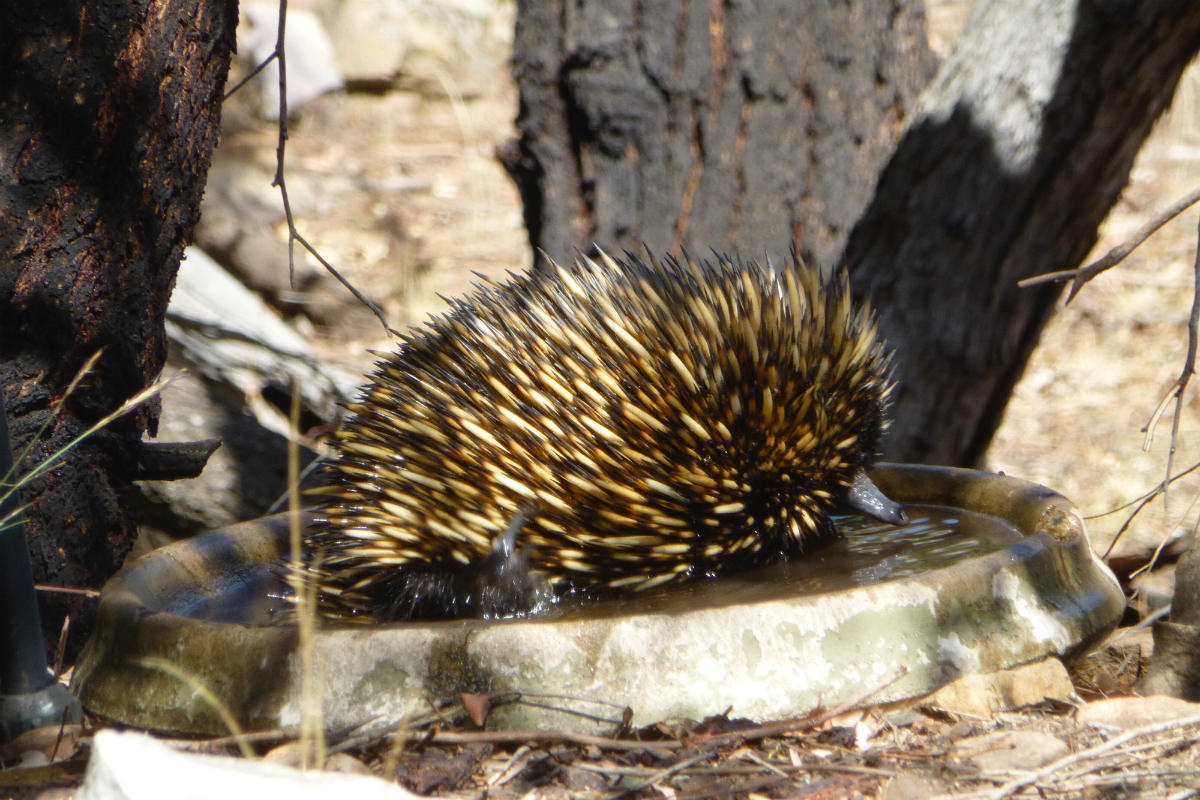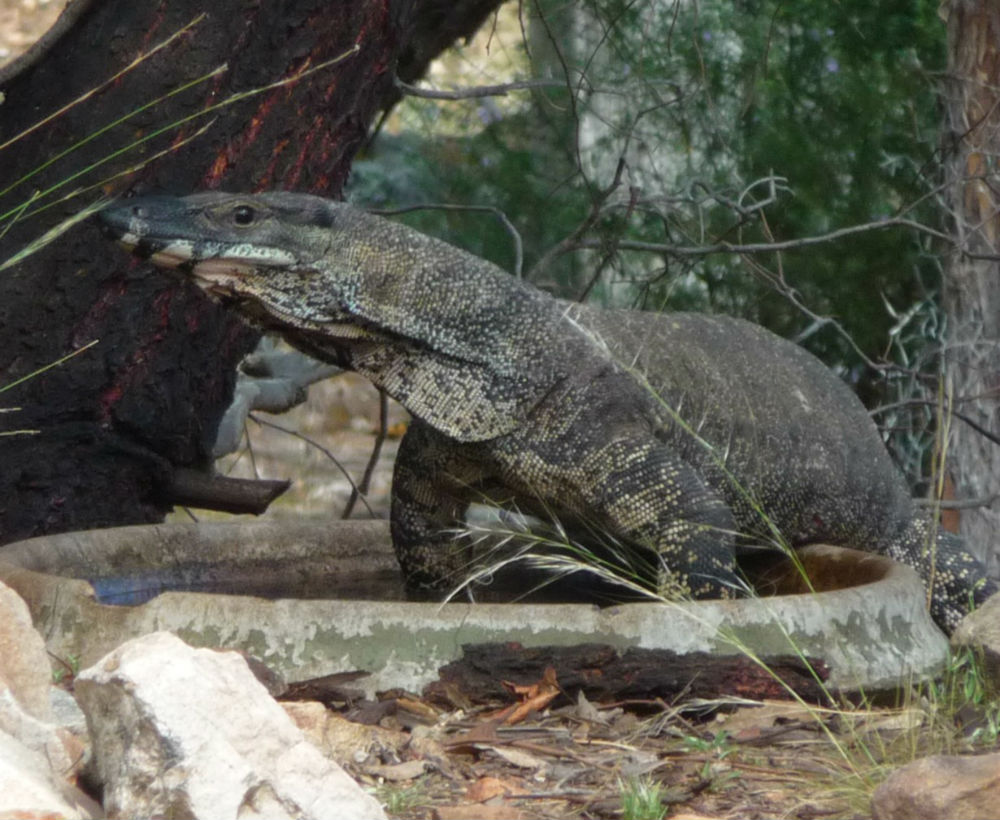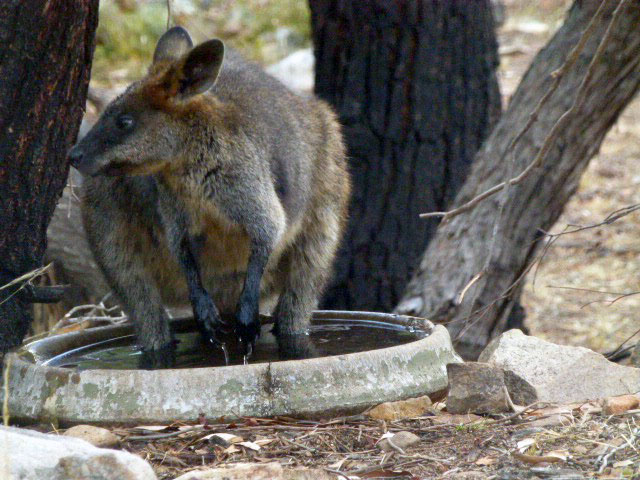Bird bath
The Bird Bath in the Buffer Zone
Do you remember this old concrete bird bath? It’s maybe 50 years old, has bits chipped off and someone once painted it green. It’s never been beautiful and the last owners left it behind when I bought ‘the block’, 20 years ago. Did I tell you what happened then? I’d already filled it with water and around noon I was staring out at a hot bare rocky slope. My idea had been to renew and conserve an ecological habitat on some non-agricultural land. That day it just seemed like 30 hectares of barren dust, rocks and stumps but as I gazed at it a dark shape down the slope moved. It was an echidna. It lumbered past me, leaned over the edge of the bath and took a long drink, heaved up higher again and lay in the water for maybe 5 minutes, scratching and trying to get wet. It got out, stood stock-still for couple of minutes then set off down the hill like a little truck with its brakes off.

Photo: Barbara Holloway
Maybe it wasn’t going to be such a depressing waste of a place after all. Since that day I’ve thought of the bird bath as the popular ‘wet bar’ for drinkers however they come. It sort of stands for both the whole place and running it. Yes ‘the block’ is a damaged part of a damaged ecosystem. As a neighbour said: ‘We certainly got plenty of rocks out here. They drop out of the bloody sky. Just got to work around them somehow.’
Layers of the light soil have washed and blown away with persistent grazing, clearing and burning. However, multitudes of lives –insects, birds, reptiles, certain plants and more – still live here or visit. National Parks and Wildlife Service rangers came and visited; we signed a Conservation Agreement to preserve most of ‘the block’ for as long as possible under the current laws. It has value as a buffer zone, a corridor down this western slope of the Dananbilla Range, to join the National Park at the top with the creek across the lane at the foot, with a little bit of White Box Grassy Woodland status too.
I keep lists of the birds that come; speckled warblers and thornbills that hang out together, the yellow robins and pardalotes that come to the bar as the sun hits it in the morning and again in the afternoon while the choughs, butcher birds and babblers drop by in the middle of the day. People who’ve lived around here all their lives say there isn’t the natural water there once was. Little springs used to run out between the rocks and there was nearly permanent water in pools down the range. Since I’ve been here that water has only been here twice, after floods. Even the stretch of Murringo Creek across the lane has changed since then as the soil washing into it from the cropping and grazing paddocks upstream has made ‘sand slugs’ that cover the stream bed. The plant and creaturely life in its narrow run of water is mostly gone, except for the long-necked turtles. And carp. On the other hand, we did see a pair of night herons hunting there, so it’s not all bad.

I am sad to see kingfishers come to the wet bar – they surely should be bathing along a watercourse, not in two centimetres of warm water in a circle of concrete. The animals too, should be able to have a swim, not just wet their feet. In my time, a flock of Apostle Birds has moved from further west but where there were flocks of a dozen brown quail at first, I’ve only seen a single pair in recent years. Pairs of superb parrots nest in the ancient white-box trees along the lane and though I thought the flock of grey-crowned babblers had gone, it turned out they’d just moved to a fresh location.
This was entirely Wiradjuri country until the 1830s. The land on this side of the range was subdivided into 30 hectare blocks in the 1950s, which was unusual then, and the lower slopes were cleared, ploughed and sown. Nobody built a house here before the 1980s but you get a real sense of continuity with its pasts through objects you come across that are much older than the bird bath, like white quartz scrapers that Aboriginal people made and used maybe 150, maybe 1,500 or 15,000 years ago, as well as things like the easily-dated Bunyip rabbit trap I found up the range, the cup without a handle that a timber-cutter or farmhand must have lost one smoko and rusty tins round an old campfire site.

Photo: Barbara Holloway
The rocks that have been piled into cairns and down tree-root holes show how closely people attended to getting every possible blade of grass to grow. Sheep would have been sent ‘up the range’ at the end of summer or in desperately ‘hard’ years, to browse native grasses and tussocks, the small shrubs and forbs. Across the hillside and right on top, between grey stumps sawn off hip-high and skeletons of the trees ringbarked long ago, old trees still live and blossom for the honey-eaters – stringy-bark, iron-bark and red gum, yellow box – and the native callitris endlechorii pine grows. These pines are now so dense nothing but seasonal spreads of mosses, lichen and the indestructible stone fern can germinate below them. I’ve had grants from National Parks to cut down swathes of the pines and pile them in ‘leaky weirs’ along the slope. My neighbours did the chain-sawing, I grow acacia seedlings within them. We were very proud when the Ranger brought a group of volunteer workers from Canberra to see what we were doing.
There have been a lot of workers in the last 100 years but no one knowledgeable would buy it as their mainstay. My predecessors hoped it would be and planted a peach and almond orchard but after the grasshoppers ate the foliage, they found marijuana grew more easily. I’ve worked at getting trees and understorey re-established on the lower slopes. They thrive in the light soil even with its stones. Revegetating works by serious vigilance to tree guards and enclosures for the other problem: kangaroos. Eastern Greys have built up in astonishing numbers and they, along with a few wallabies, wallaroos and hares, are relentless. If you aren’t a vegetarian, eat more roo, I say.
The old concrete wet bar has provided water for all of them, but frost and heat have widened its cracks until it only holds a sip. It will have to be replaced. Drinkers, bathers and water-suppliers alike, we’ll have to move with the times and see if there’s a fibreglass version.
Barbara Holloway grew up on a sheep farm and divides her time between trying to keep things growing within their biosystems and trying to write about place as a Visiting Fellow at ANU.

